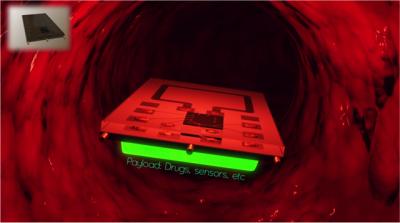Fantastic Voyage: implantable medical device can propel itself through bloodstream
February 23, 2012

Stanford engineers have developed a wirelessly powered, self-propelled medical device that can propel itself through the blood stream to deliver drugs, perform diagnostics or microsurgeries (credit: Carlos Suarez, StrongBox3d)
Electrical engineer Ada Poon has developed a tiny, wirelessly powered, self-propelled medical device capable of controlled motion through the bloodstream.
Poon, an assistant professor at the Stanford School of Engineering, is developing a new class of medical devices that can be implanted or injected into the human body and powered wirelessly using radio waves. No batteries to wear out. No cables to provide power.
“Applications include everything from diagnostics to minimally invasive surgeries,” she said. They could travel through the bloodstream to deliver drugs, perform analyses, and perhaps even zap blood clots or removing plaque from sclerotic arteries.
Poon’s devices consist of a radio transmitter outside the body sending signals to an independent device inside the body that picks up the signal with an antenna of coiled wire. The transmitter and the antenna are magnetically coupled such that any change in current flow in the transmitter induces a voltage in the coiled wire.
New tissue model allows for tiny antennas
For fifty years, scientists have been working on wireless electromagnetic powering of implantable devices, but they ran up against mathematics. According to the models, high-frequency radio waves dissipate quickly in human tissue, fading exponentially the deeper they go. Low-frequency signals, on the other hand, penetrate well, but require antennas a few centimeters in diameter to generate enough power for the device, far too large to fit through all but the biggest arteries.
Poon took a different tack, choosing instead to model tissue as a dielectric — a type of insulator. As it turns out human tissue is a poor conductor of electricity. But, radio waves can still move through them. In a dielectric, the signal is conveyed as waves of shifting polarization of atoms within cells. Even better, Poon also discovered that human tissue is a “low-loss” dielectric — that is to say little of the signal gets lost along the way.
She recalculated and made a surprising find: Using new equations she learned high-frequency radio waves travel much farther in human tissue than originally thought. “When we extended things to higher frequencies using a simple model of tissue we realized that the optimal frequency for wireless powering is actually around one gigahertz,” said Poon, “about 100 times higher than previously thought.”
More significantly, however, her revelation meant that antennas inside the body could be 100 times smaller and yet deliver the same power. The antenna on a device Poon developed is just two millimeters square; small enough to travel through the bloodstream.
She has developed two types of self-propelled devices. One drives electrical current directly through the fluid to create a directional force that pushes the device forward. This type of device is capable of moving at just over half-a-centimeter per second. The second type switches current back-and-forth in a wire loop to produce swishing motion similar to the motion a kayaker makes to paddle upstream.
“There is considerable room for improvement and much work remains before these devices are ready for medical applications,” said Poon. “But for the first time in decades the possibility seems closer than ever.”